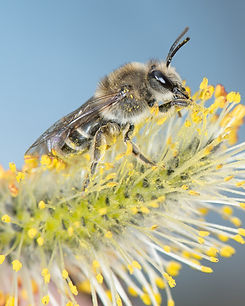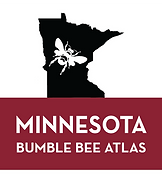
Bee Basics
What makes a bee, a bee? Are they just hairy wasps or are there more similarities than differences between bees and wasps? Learn about their evolution, some of the characteristics that make a bee, a bee, as well as their similarities and relationship to wasps.
There are many insects—flies, wasps, beetles, moths, and more—that resemble or mimic bees. Learn about some of these common mimics and develop skills to tell them apart from bees.
Learn about the opportunities as well as the limitations for identifying bees to species. Approximately 20% of bees occurring in Minnesota could be identified to species using multiple clear photographs detailing specific identification characteristics.
Bees nest in a variety of places either belowground or aboveground. Both ground-nesting and cavity-nesting bees line and waterproof their nests. Learn about which materials are used to ensure the larvae have unspoiled food and climate-controlled brood cells.
Each brood cell is stocked with pollen provisions, usually by a single female bee. Larvae consume these provisions as they develop and many have specialist pollen diets. To sustain their activities, adult bees feed on pollen and nectar provided by flowers.
Do all bees live in hives and make honey? Do bees sting more than once or die after they sting? "I saw a small bee, will it get larger once it consumes food?" Myth-busting answers await!
Common Backyard Bees
How to Help Bees

Provide Food
1
Flower Diversity
Plant a diversity of flowering plants (trees, shrubs, and perennials) that are native to your region. Aim for the planting to include at least 70% native plants species including host plants for specialist bees, with the minority of plants being cultivars or exotic species.
2
Flower Shape and Color
Provide flowers with a variety of colors and forms—both simple (open) and complex ones that serve a diversity of bees.
3
24/7 Flower Buffet
Offer a continuous succession of flowers for the entire growing season. Prioritize plants that bloom in spring and early autumn.

Provide Nesting Habitat
4
Avoid using landscape fabric, plastic, or other soil coverings that inhibit nesting opportunities for ground-nesting bees. Do not disturb existing nest sites.
5
Leave perennial plant stem stubble (8-24" high) when cutting back plant material to provide nesting opportunities for cavity-nesting bees.
6
Provide dead tree trunks, stumps, or logs lying on the ground for bees to nest in preexisting holes in wood.

Protect Bees From Harm
7
Do not use pesticides of any kind (insecticides, fungicides, herbicides) including spraying a yard for mosquitoes, including organic insecticides. Use compost instead of synthetic fertilizers.
8
Remove invasive plant species that degrade bee-dependent natural habitat. Volunteer to restore natural resources to create resilient and diverse habitat for bees.
9
Do not introduce managed bee species, or purchase and release bees that can compete for food and nesting sites, and transmit diseases to local native bee populations.

Advocacy to Action
10
Place a bee or pollinator habitat sign in your garden. Talk to your neighbors and friends about the importance of native bees, and other pollinating and beneficial insects.
11
Pollinators are suffering due to climate change. Select clean energy options and support environmental regulations. Plant trees, restore and recreate grasslands, and choose more plant-based food options.
12
Collect and share bee observations with other bee enthusiasts and scientists. There are a number of opportunities to get involved. See below for more information.
Participatory Science Opportunities

Looking for a bee ID?
To get help with bee identifications, create a free iNaturalist or BugGuide account then upload your bee photo(s) to one of these sites. Experts will help you identify your bee. Once your bee is identified, visit this site to learn more about its natural history, nesting preferences, and conservation.
Explore the Guide

Apidae
15 genera, 133 species
Bumble bees Bombus
Longhorn bees
Epimelissodes, Eucera, Melissodes
Carpenter bees
Ceratina, Xylocopa
Honey bees Apis
Digger bees Anthophora
Cuckoo bees Brachymelecta, Epeolus, Holcopasites, Nomada, Neolarra, Triepeolus
Squash bees Xenoglossa

2 genera, 39 species
Halictidae
10 genera, 133 species
Metallic green sweat bees
Agapostemon, Augochlora, Augochlorella, Augochloropsis
Large sweat bees
Dieunomia, Nomia
Short-faced bees Dufourea
Sweat bees Halictus
Small sweat bees Lasioglossum
Cuckoo (blood) bees Sphecodes
Megachilidae
14 genera, 86 species
Resin and pebble bees Anthidiellum, Dianthidium, Heriades, Paranthidium
Carder bees Anthidium, Pseudoanthidium
Mock orange bees Chelostoma
Mason bees Osmia, Hoplitis
Leafcutter bees Megachile
Sharp-tailed cuckoo bees Coelioxys
Dark cuckoo bees Stelis

Page Photography Credits
Heather Holm






























